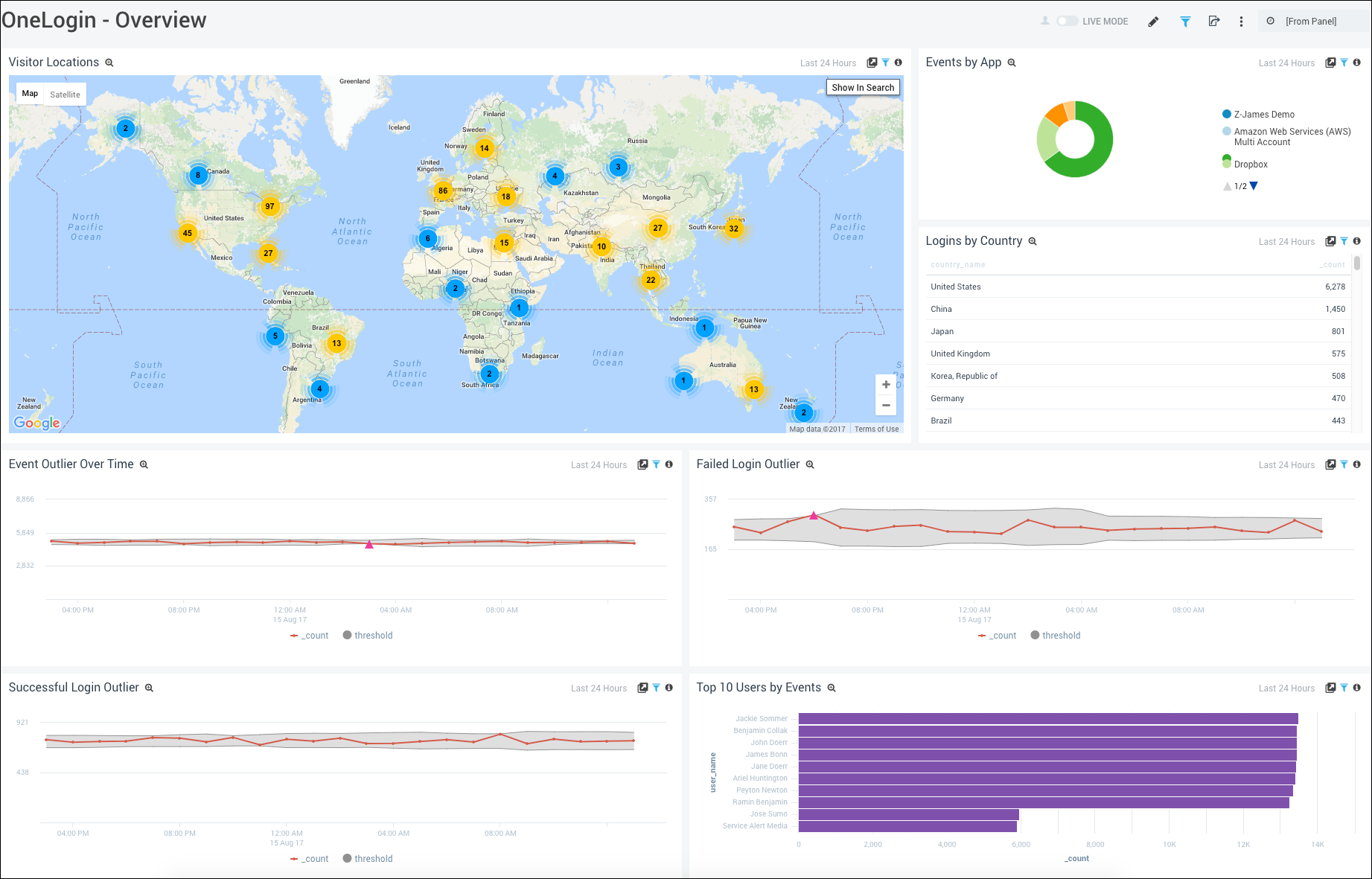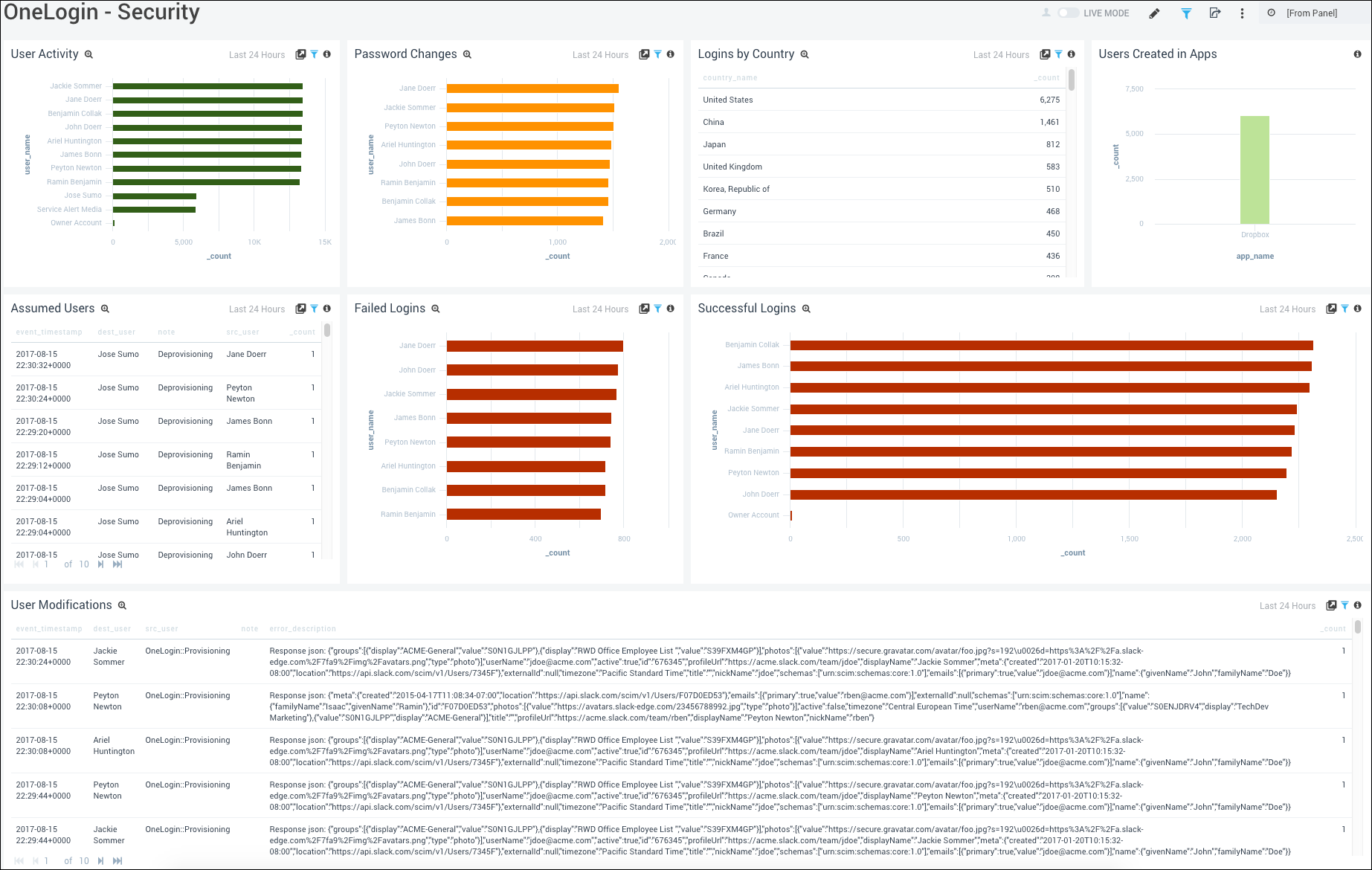OneLogin

OneLogin is an Identity Management provider that supplies a comprehensive set of enterprise-grade identity and access management solutions, including single sign-on (SSO), user provisioning, and multi-factor authentication (MFA). The Sumo Logic app for OneLogin provides real-time visibility and analysis of OneLogin user activity through event data, such as user logins, administrative operations, and provisioning.
Prerequisites
To use this feature, you'll need to enable access to your OneLogin logs and ingest them into Sumo Logic.
Once you begin uploading data, your daily data usage will increase. It's a good idea to check the Account page in Sumo Logic to make sure that you have enough quota to accommodate additional data in your account. If you need additional quota you can upgrade your account at any time.
- OneLogin Enterprise or Unlimited plan subscription.
- Configure an Event Broadcaster
- Add a Sumo Logic Hosted Collector to your Sumo Logic Org.
- Configure an HTTP Source for your OneLogin data. Make sure to set the Source Category when configuring the OneLogin source. For example, onelogin.
- From OneLogin, configure a broadcaster that points to this endpoint using the instructions in the OneLogin documentation. You must use SIEM (NDJSON) format. Use the Sumo Logic HTTP Source URL as the Listener URL, and custom header is not needed.
Log types
The Sumo Logic app for OneLogin uses event logs in NDJSON format.
Sample log messages
Each event is a single-line JSON, containing information such as:
{
"event":{
"create":{
"_id":"443ce874-7704-54d2-b12f-b6e4a72ec6ef"
},
"entity":null,
"role_id":null,
"client_id":null,
"trusted_idp_name":null,
"notes":null,
"app_name":null,
"service_directory_id":null,
"actor_system":"",
"login_name":null,
"assuming_acting_user_id":null,
"mapping_name":null,
"directory_sync_run_id":null,
"api_credential_name":null,
"directory_id":null,
"certificate_id":null,
"group_id":null,
"role_name":null,
"imported_user_name":null,
"resolved_at":null,
"mapping_id":null,
"authentication_factor_type":null,
"user_field_name":null,
"proxy_ip":null,
"certificate_name":null,
"task_name":null,
"adc_id":null,
"uuid":"443ce874-7704-54d2-b12f-b6e4a72ec6ef",
"note_title":null,
"event_timestamp":"2017-03-21 00:09:27+0000",
"actor_user_name":"Peyton Newton",
"proxy_agent_id":null,
"otp_device_name":null,
"actor_user_id":11826257,
"trusted_idp_id":null,
"imported_user_id":null,
"policy_type":null,
"user_id":11826257,
"resource_type_id":null,
"login_id":null,
"solved":null,
"policy_id":null,
"policy_name":null,
"otp_device_id":null,
"radius_config_name":null,
"app_id":null,
"user_name":"Peyton Newton",
"account_id":22348,
"resolved_by_user_id":null,
"radius_config_id":null,
"error_description":null,
"note_id":null,
"param":null,
"event_type_id":11,
"proxy_agent_name":null,
"privilege_id":null,
"user_field_id":null,
"authentication_factor_description":null,
"ipaddr":"137.219.197.240",
"custom_message":null,
"directory_name":null,
"object_id":null,
"group_name":null,
"resolution":null,
"privilege_name":null,
"authentication_factor_id":null,
"adc_name":null
}
}
Sample queries
_sourceCategory=onelogin
| json "event.event_type_id", "event.app_name","event.ipaddr", "event.user_name", "event.actor_user_name" as event_id, app_name, src_ip, user_name, actor_user_name
| where event_id in ("10","11")
| count by user_name
| sort by _count
Installing the OneLogin app
To install the app, do the following:
- Select App Catalog.
- In the 🔎 Search Apps field, run a search for your desired app, then select it.
- Click Install App.
note
Sometimes this button says Add Integration.
- Click Next in the Setup Data section.
- In the Configure section of your respective app, complete the following fields.
- Key. Select either of these options for the data source.
- Choose Source Category and select a source category from the list for Default Value.
- Choose Custom, and enter a custom metadata field. Insert its value in Default Value.
- Key. Select either of these options for the data source.
- Click Next. You will be redirected to the Preview & Done section.
Post-installation
Once your app is installed, it will appear in your Installed Apps folder, and dashboard panels will start to fill automatically.
Each panel slowly fills with data matching the time range query and received since the panel was created. Results will not immediately be available, but will update with full graphs and charts over time.
Upgrading the OneLogin app (Optional)
To update the app, do the following:
- Select App Catalog.
- In the Search Apps field, search for and then select your app.
Optionally, you can identify apps that can be upgraded in the Upgrade available section. - To upgrade the app, click Upgrade.
- If the upgrade does not have any configuration or property changes, you will be redirected to the Preview & Done section.
- If the upgrade has any configuration or property changes, you will be redirected to Setup Data page.
- In the Configure section of your respective app, complete the following fields.
- Key. Select either of these options for the data source.
- Choose Source Category and select a source category from the list for Default Value.
- Choose Custom and enter a custom metadata field. Insert its value in Default Value.
- Key. Select either of these options for the data source.
- Click Next. You will be redirected to the Preview & Done section.
- In the Configure section of your respective app, complete the following fields.
Post-update
Your upgraded app will be installed in the Installed Apps folder, and dashboard panels will start to fill automatically.
See our Release Notes changelog for new updates in the app.
Uninstalling the OneLogin app (Optional)
To uninstall the app, do the following:
- Select App Catalog.
- In the 🔎 Search Apps field, run a search for your desired app, then select it.
- Click Uninstall.
Viewing OneLogin dashboards
All dashboards have a set of filters that you can apply to the entire dashboard. Use these filters to drill down and examine the data to a granular level.
- You can change the time range for a dashboard or panel by selecting a predefined interval from a drop-down list, choosing a recently used time range, or specifying custom dates and times. Learn more.
- If required, configure the refresh interval rate for a dashboard or panel by clicking the drop-down arrow next to the refresh icon.
- Click the funnel icon in the dashboard top menu bar to filter dashboard with Template Variables.

Overview
Visitor Locations. See the count and location of visitor IP addresses over the last 24 hours on the world map.
Events by App. See events from the last 24 hours by application name in a pie chart and compare app usage.
Logins by Country. See the count of number of logins by country name displayed in a table to get an idea of your visitor traffic by country in the last 24 hours.
Event Outlier Over Time. See the events that fall outside the normal range for the last 24 hours.
Failed Login Outlier. See any logins over the last 24 hours that fall outside the specified failed login threshold.
Successful Login Outlier. See any logins over the last 24 hours that fall outside the specified successful login threshold.
Top 10 Users by Events. View the top 10 users by number of events for the last 24 hours to identify heavy activity.

App Monitoring
Event Distribution by App. See the percentage of events by application in the last 24 hours as a pie chart to identify the event distribution by apps having the most events recently.
Event Distribution by Event ID. See the percentage of each user action by Event ID for the last 24 hours as a pie chart to identify the apps having the most activity recently.
Logins by App. See the percentage of logins by application in the last 24 hours as a pie chart to identify the apps having the most events recently.
Top 10 Provisioning Errors and Warnings. See the top 10 provisioning error messages and warnings issued by OneLogin by count for the last 24 hours.
Failed Actions. See the error descriptions of failed actions and a count of the occurrence for the last 24 hours displayed in a table to identify possible issues.

Security
User Activity. View the count of user activities by username as a bar chart for the last 24 hours as a bar chart to quickly identify unusual user activity.
Password Changes. See the count of password changes by username as a bar chart for the last 24 hours to quickly identify any unusually high numbers of password changes by a particular user.
Logins by Country. View the count of the logins by country in the last 24 hours to identify any unusual activity by country.
Users Created in Apps. See the number of users created in applications in the last 24 hours as a column chart. You can filter by app name to track the count of a particular app.
Assumed Users. View the details such as the timestamp, destination user, notes, source user, and count for the event when one user acted as another user in the last 24 hours.
Failed Logins. See the number of login failures by username in the last 24 hours on a bar chart to identify any unusual activity. You can filter by username as needed.
Successful Logins. See the number of successful logins by username in the last 24 hours to identify any unusual activity. You can filter by username as needed.
User Modifications. See user modifications by timestamp, destination user, source user, notes, and error description for the last 24 hours displayed in table. You can filter by time, user name, source user, or error description as needed to track unusual behavior.
